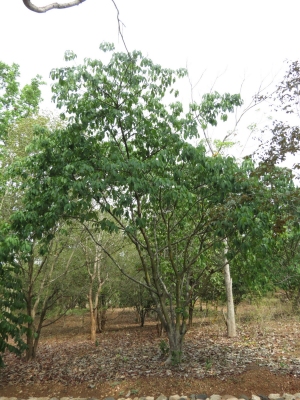Ficus tsjakela
Burm.f.
Moraceae
Common Name:

Cultivated plant in Nilgiri Biosphere Nature park, Anaikatty Coimbatore.
Photograph by: Forestowlet
Creative Commons Attribution-Share Alike 3.0

Cultivated plant in Nilgiri Biosphere Nature park, Anaikatty Coimbatore.
Photograph by: Forestowlet
Creative Commons Attribution-Share Alike 3.0

Foliage
Photograph by: Forestowlet
Creative Commons Attribution-Share Alike 3.0

Developing fruits
Photograph by: Forestowlet
Creative Commons Attribution-Share Alike 3.0

Close-up of the leaves
Photograph by: Forestowlet
Creative Commons Attribution-Share Alike 3.0
General Information
Ficus tsjakela is a large, briefly deciduous tree[
146- Title
- A Manual of Indian Timbers.
- Publication
-
- Author
- Gamble. J. S.
- Publisher
- Bishen Singh Mahendra Pal Singh
- Year
- 1972
- ISBN
- -
- Description
- First written in the 19th century, but still a classic, giving a lot of information on the uses and habitats of Indian trees. Not for the casual reader.
].
The tree is cultivated in southern India to provide shade in coffee plantations[
].
Known Hazards
None known
Botanical References
464- Title
- A Handbook to the Flora of Ceylon
- Publication
-
- Author
- Trimen H.; continued by Hooker J.D.
- Website
- http://www.biodiversitylibrary.org
- Publisher
- Dulau and Co; London.
- Year
- 1898
- ISBN
-
- Description
- Very dated, but still a useful work. It can be downloaded from the Internet.
Range
E. Asia - India, Sri Lanka.
Habitat
Moist regions at elevations up to 600 metres in Sri Lanka[
464- Title
- A Handbook to the Flora of Ceylon
- Publication
-
- Author
- Trimen H.; continued by Hooker J.D.
- Website
- http://www.biodiversitylibrary.org
- Publisher
- Dulau and Co; London.
- Year
- 1898
- ISBN
-
- Description
- Very dated, but still a useful work. It can be downloaded from the Internet.
]. Forests[
146- Title
- A Manual of Indian Timbers.
- Publication
-
- Author
- Gamble. J. S.
- Publisher
- Bishen Singh Mahendra Pal Singh
- Year
- 1972
- ISBN
- -
- Description
- First written in the 19th century, but still a classic, giving a lot of information on the uses and habitats of Indian trees. Not for the casual reader.
].
Properties
| Other Uses Rating |      |
| Habit | Deciduous Tree |
| Height | 0.00 m |
| Pollinators | Wasps |
| Cultivation Status | Cultivated, Wild |
Cultivation Details
Fig trees have a unique form of fertilization, each species relying on a single, highly specialized species of wasp that is itself totaly dependant upon that fig species in order to breed. The trees produce three types of flower; male, a long-styled female and a short-styled female flower, often called the gall flower. All three types of flower are contained within the structure we usually think of as the fruit.
The female fig wasp enters a fig and lays its eggs on the short styled female flowers while pollinating the long styled female flowers. Wingless male fig wasps emerge first, inseminate the emerging females and then bore exit tunnels out of the fig for the winged females. Females emerge, collect pollen from the male flowers and fly off in search of figs whose female flowers are receptive. In order to support a population of its pollinator, individuals of a Ficus spp. must flower asynchronously. A population must exceed a critical minimum size to ensure that at any time of the year at least some plants have overlap of emmission and reception of fig wasps. Without this temporal overlap the short-lived pollinator wasps will go locally extinct[
413- Title
- Global Invasive Species Database
- Publication
-
- Author
-
- Website
- http://www.issg.org/database/welcome/
- Publisher
-
- Year
- 0
- ISBN
-
- Description
- Very detailed information on almost 400 species (with more being added) of plants that have become weeds in areas outside their native range.
].
Edible Uses
None known
Medicinal
None known
Agroforestry Uses:
The tree is often planted in order to provide shade for trees in coffee plantations[
146- Title
- A Manual of Indian Timbers.
- Publication
-
- Author
- Gamble. J. S.
- Publisher
- Bishen Singh Mahendra Pal Singh
- Year
- 1972
- ISBN
- -
- Description
- First written in the 19th century, but still a classic, giving a lot of information on the uses and habitats of Indian trees. Not for the casual reader.
].
Other Uses
The brown wood is soft, in alternate concentric rings of narrow dark loose tissue and broader pale firmer tissue, the
dark layers very conspicuous on a vertical section[
146- Title
- A Manual of Indian Timbers.
- Publication
-
- Author
- Gamble. J. S.
- Publisher
- Bishen Singh Mahendra Pal Singh
- Year
- 1972
- ISBN
- -
- Description
- First written in the 19th century, but still a classic, giving a lot of information on the uses and habitats of Indian trees. Not for the casual reader.
]. No uses are mentioned.
Propagation
Seed -
If you have any useful information about this plant, please leave a comment. Comments have to be approved before they are shown here.





 Useful Tropical Plants Database 2014 by
Ken Fern,
web interface by
Ajna Fern
with help from
Richard Morris.
Useful Tropical Plants Database 2014 by
Ken Fern,
web interface by
Ajna Fern
with help from
Richard Morris.